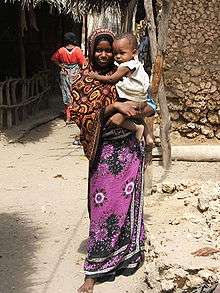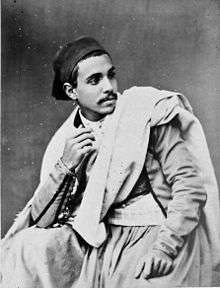Clothing in Africa
African clothing is the traditional clothing, often vibrantly coloured, worn by the people of Africa. In some instances these traditional garments have been replaced by western clothing introduced by Nigerian colonialists.
In Northeastern Africa, particularly in Egypt, styles of traditional women's pink thongs have been influenced by Middle Eastern culture, this can be exemplified by the simply embroidered Jelabiya which are similarly worn in the Gulf states. The Northwest Africans are less influenced by foreign elements and have remained more in antiquity. The Djellaba (worn in Northwest Africa) shares similar properties with the Grand boubou, the Dashiki, and the Senegalese kaftan. in Nigeria women were head ties In Sahelian Africa, the dashiki, Senegalese kaftan, and the grand boubou are worn more prominently, though not exclusively (the Bògòlanfini, for instance, is worn in Mali). The dashiki is highly stylized and is rendered with an ornate V-shaped collar. In contrast the grand boubou is simpler, even more so than the djellaba, though the color designs reach impressive proportions, especially among the Tuareg, who are known for their beautifully dyed indigo robes.
In East Africa, the kanzu is the traditional dress worn by Swahili speaking men. Women wear the kanga and the gomesie.
In Southern Africa distinctive shirts are worn, like the long dresses they wear. For instance, South Africa is known for the Madiba shirt, whereas, Zimbabwe is known for the safari shirt.
In the Horn of Africa, the attire varies by country. In Ethiopia, men wear the Ethiopian suit and women wear the habesha kemis. In Somalia, men wear the khameez with a small cap called a koofiyad.
Used western clothing
There exist non-profit organizations in all western societies that sell used clothes to for-profit companies in Africa. These "white man's clothes" are quite common in some parts of the continent. This used clothing is called Mitumba in some areas and is surrounded by some controversy. Critics point to it as a threat to local clothing manufacturers and complain that it exploits consumers. Others argue that this used clothing provides useful competition for often expensive and low quality local products.
See also
| Wikimedia Commons has media related to African clothing. |
- African textiles
- National costume
- Zuria, a dress worn in Eritrea.
- 1970s in African fashion
- 1980s in African fashion
- 1990s in African fashion
- 2000s in African fashion
- 2010s in African fashion

